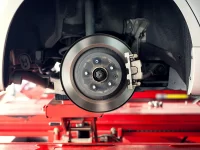The evolution of the motorcycle knee pads

The knee slider, called a “bar of soap” in Italian, is an essential part of the leather suit. For amateurs taking to the track for the first time, a scratched slider is proof that you had a great day. For experts, it’s one of many things that may be taken for granted but contribute to performance. That’s clear. There’s nothing unusual about a rider’s knee slipping on the asphalt or curb. Fifty years ago, however, it was different. Such angles were unthinkable, and a knee so close to the ground meant a front-page photo for the most popular weekly newspaper.
But in 1978, a Martian with a California passport and the name Kenny Roberts came to the motorcycle GPs. He came with a brand new Fahrstil that would revolutionize the design of Grand Prix suits in no time. He leans his body more than anyone else and feels the need to have a third point of contact with the track. It was the first time anyone got into the habit of driving with his knee on the ground. He immediately set a trend. Everyone knew the die was cast and started copying King Kenny and his black and yellow bike.
The skin wouldn’t do. It wouldn’t slide, wouldn’t stand up to the abrasion of the asphalt. An alternative was needed, and someone came up with the idea of used visors. They were shaped to the rider’s liking and taped to the suit, allowing the knees to rest on the ground and slide, and the riders to concentrate on their speed in the turn. The idea came from the riders, who decided to experiment with a handmade solution in the middle of a race weekend, but it clearly pointed to an emerging need.

Suit manufacturers quickly stepped up to help the riders perform at their best and experience the new riding style. And so the first rudimentary Knieschoner was developed. Over the next ten years, it was further developed and refined until it took on its current form.







